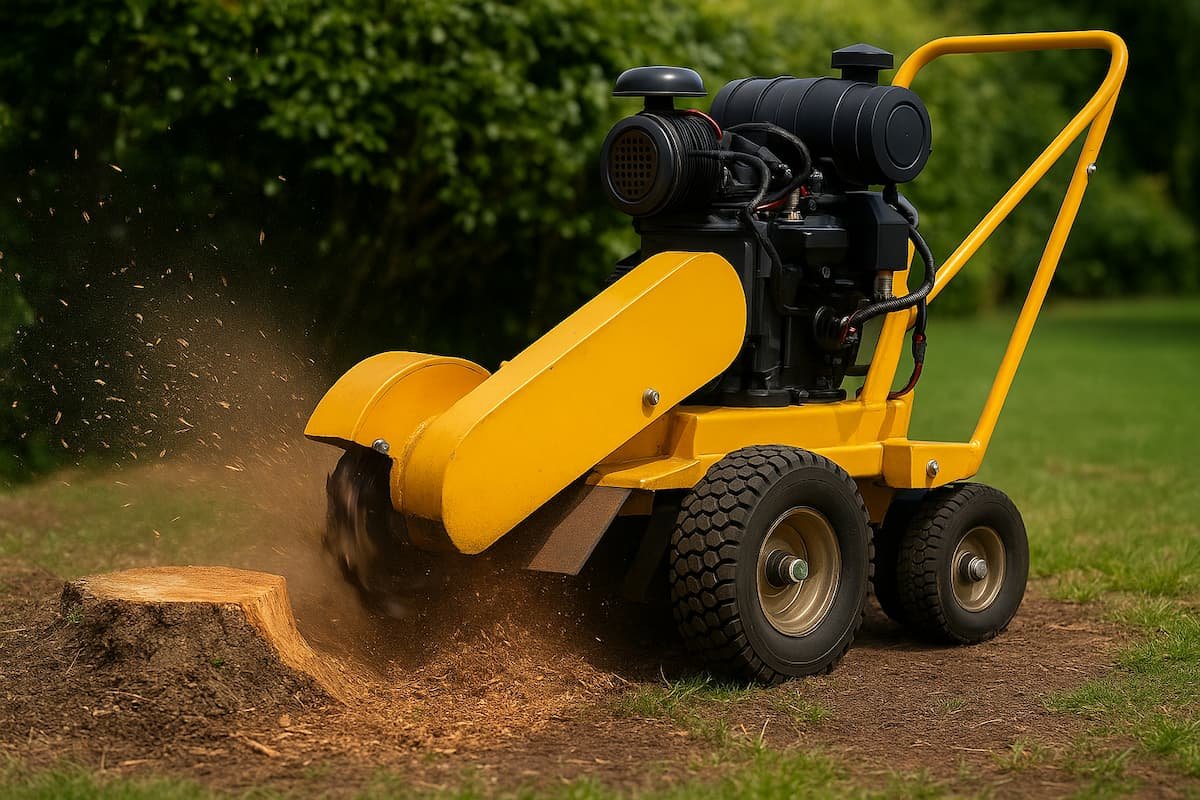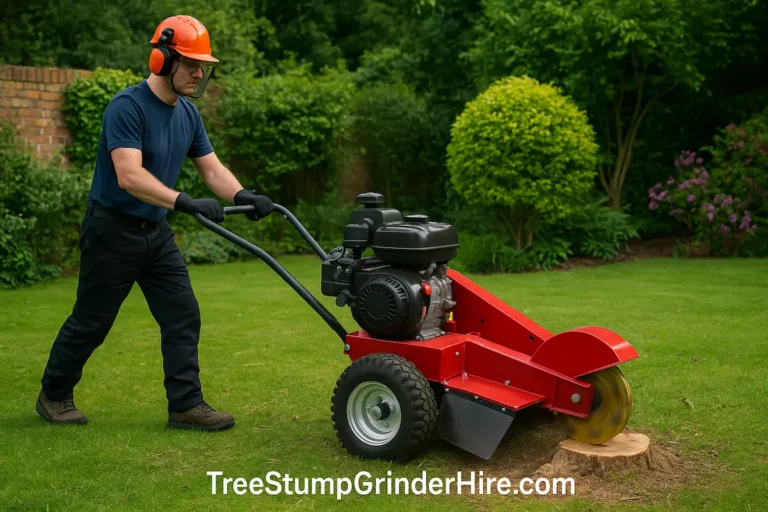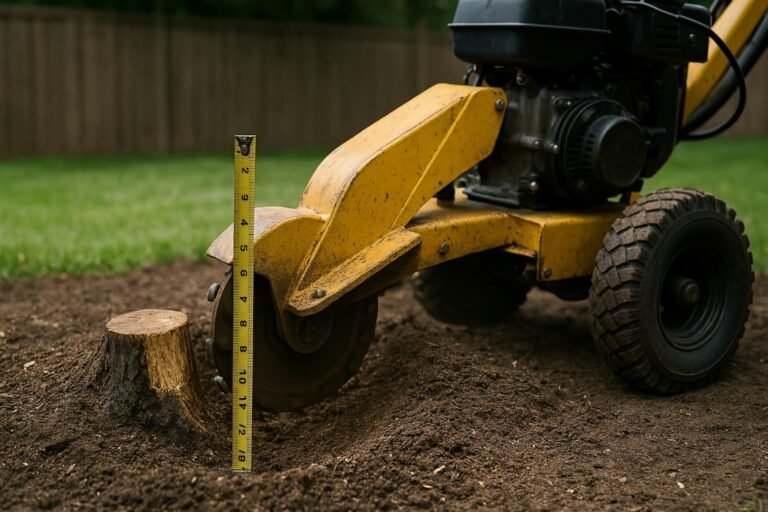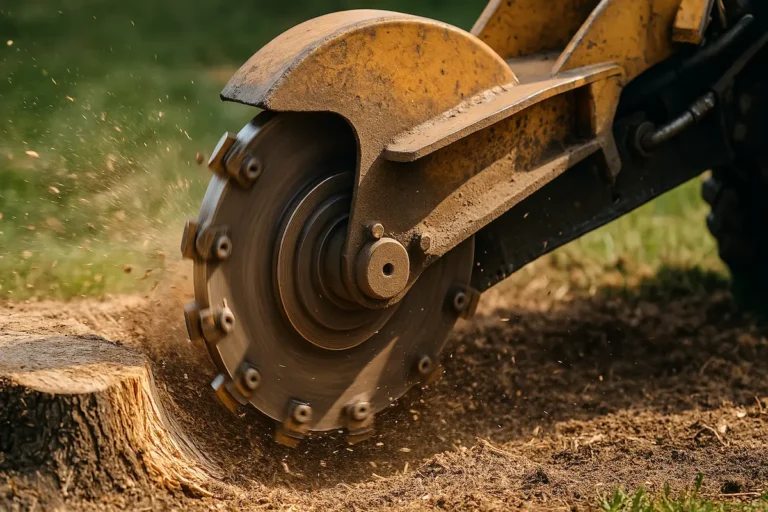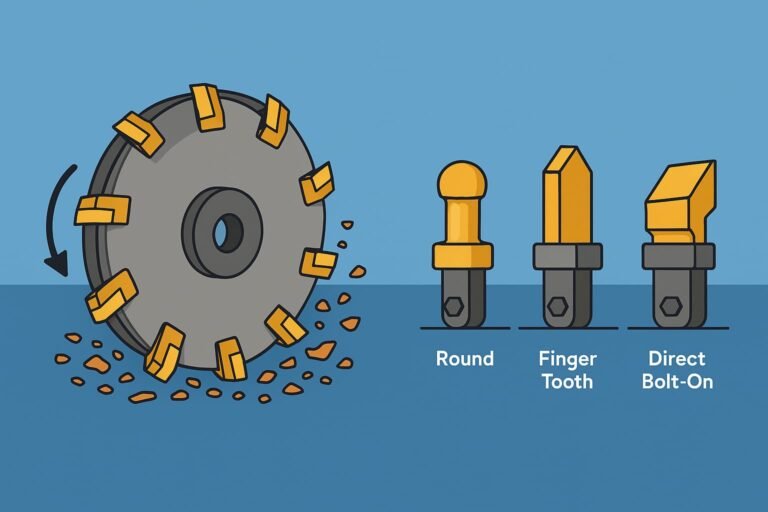Understanding RPM: What You Need to Know Before Hiring a Stump Grinder
Want to know about stump grinder speed?
RPM stands for Revolutions Per Minute.
It tells you how fast parts of the grinder are spinning.
Understanding RPM helps you pick the right machine for your job.
This guide explains RPM.
Stump Grinder: Cutter Wheel Speed vs. Torque
Key Takeaways from the Chart
- This chart compares typical Cutter Wheel Speed (RPM) and Torque (Turning Force) for common hire stump grinder types. Higher values indicate more speed or force relative to the other type.
- Small Petrol Grinders (often belt-driven, shown in red) generally have higher wheel speed but moderate torque. This makes them feel fast and efficient for smaller, softer stumps, but they might struggle or slow down significantly on large, hard ones.
- Large Hydraulic Grinders (shown in blue) typically operate with lower wheel speed but deliver much higher torque. Their brute force makes them ideal for powering through large, dense hardwood stumps consistently, even if the wheel spins slower.
- Notice the trade-off: the grinder type with higher speed has lower torque, and the one with higher torque has lower speed.
- Choose the right balance for your job: Match the grinder’s strengths (Speed for smaller/softer jobs vs. Torque for larger/harder jobs) to your specific stumps. Consider both stump size and wood hardness.
What Exactly is RPM in Stump Grinding?
RPM means Revolutions Per Minute.
It counts how many times something spins around in one minute.
Think about a spinning top or a bike wheel.
RPM measures how fast they spin.
For stump grinders, RPM is essential.
It tells us about the machine’s speed and power.
Knowing about RPM helps you understand how a grinder works.
It also helps you choose the best grinder to hire.
Engine RPM vs Cutter Wheel RPM: A Vital Difference
Stump grinders have two main RPM numbers to think about.
It’s essential to know they are different.
1. Engine RPM:
This is how fast the grinder’s engine is running.
The engine makes the machine power.
A faster engine RPM usually means more power is available.
Small petrol engines might run up to 3600 RPM.
Bigger diesel engines often run slower, maybe 2400-2800 RPM.
However, diesel engines usually have more turning force (torque).
2. Cutter Wheel RPM:
This is how fast the actual cutting wheel spins.
The cutting wheel has sharp teeth that grind the stump.
This is the speed that directly affects how the stump is ground.
Crucially, Engine RPM and Cutter Wheel RPM are often NOT the same.
Many grinders use belts or hydraulic systems.
These systems often slow down the speed from the engine to the wheel.
Slowing the speed increases the turning force (torque) at the wheel.
More torque helps the wheel cut through tough wood without stopping.
So, a fast engine doesn’t always mean a super-fast cutting wheel.
Understanding this difference is key to choosing the right grinder.
Operator Insight:
“I always listen to the engine sound. Keeping the revs steady means the cutter wheel gets consistent power. If the engine struggles, the wheel slows down too much.”
Why RPM Matters: The Impact on Your Stump Grinding Job
The speed of the cutter wheel (Cutter Wheel RPM) changes how the grinder performs.
Here’s why RPM matters for your stump removal project:
- Grinding Speed: How quickly the job gets done.
- Cut Quality: How fine the leftover wood chips are.
- Machine Effort: How hard the grinder has to work.
- Safety: Operating the machine without extra risks.
Let’s look at each of these points more closely.
Grinding Speed and Efficiency: How Fast Can It Cut?
A faster-spinning cutter wheel (higher RPM) takes more small bites of wood per second.
This can make grinding faster, especially on:
- Smaller tree stumps.
- Softer types of wood (like pine).
But high speed isn’t everything.
The grinder also needs enough power and turning force (torque).
If the wheel spins very fast but doesn’t have much torque:
- It might get stuck or slow down in hardwood (like oak).
- It might struggle with huge stumps.
- The engine might work too hard and stall.
Think of it like cycling.
Spinning your legs fast in low gear is easy on a flat road (softwood).
But going uphill (hardwood), you must change to a lower gear.
Your legs spin slower, but you have more force (torque) to climb the hill.
Efficiency means matching the speed and torque to the job.
Cut Quality and Chip Size: Achieving the Desired Finish
The cutter wheel’s speed also changes the wood chips’ size.
Higher Cutter Wheel RPM usually creates:
- Finer wood chips are more like sawdust or mulch.
- This can be easier to clean up or mix into the soil.
Lower Cutter Wheel RPM might create:
- Coarser wood chips, larger chunks of wood.
- This might take longer to break down naturally.
The type of teeth on the wheel also affects chip size.
But wheel speed plays a big part in the final texture.
If you want excellent mulch, a higher RPM machine might be better (if suitable for the stump).
Machine Strain and Durability: Performance vs Longevity
Running any machine flat out all the time causes more wear and tear.
Constantly running the engine at its maximum RPM can shorten its life.
Grinder manufacturers design machines with specific operating speeds in mind.
The cutter wheel RPM is set based on:
- The engine’s power.
- The drive system (belts or hydraulics).
- The weight and size of the wheel.
- The strength of the bearings and other parts.
Pushing a machine beyond its designed speeds can lead to problems.
Following operating guidelines helps the hire machine last longer.
It also ensures it performs as expected for your job.
Safety First: RPM’s Role in Safe Operation
Speed affects safety when using powerful equipment.
Excessive cutter wheel speed can increase risks:
- Flying Debris: Faster spinning can throw wood chips, stones, or hidden objects further and harder. Always use guards and wear safety glasses!
- Tooth Damage: If teeth are worn, damaged, or hit something hard (like a rock), high speed increases the impact force. This could cause teeth to break or shatter.
- Machine Control: Very high speeds might make the machine more complicated to control smoothly for beginners.
Manufacturers design safety guards and features based on expected operating RPMs.
Using the machine correctly and at the right speeds is vital for safety.
Remember: Safety gear (eye protection, ear defenders, gloves, sturdy boots) is essential no matter the RPM!
The Balancing Act: Torque vs Speed in Stump Grinders
We’ve mentioned torque a few times. Let’s explain it better.
Speed (RPM) is how fast the wheel spins.
Torque is the turning force or twisting power of the wheel.
Think about opening a tight jar lid.
- You don’t need to twist it fast (low RPM).
- You need a strong, steady twist (high torque) to open it.
Stump grinding needs both speed and torque. But there’s often a trade-off.
- High Speed / Lower Torque Designs:
- Often found on smaller, belt-driven grinders.
- The wheel spins very fast (high RPM).
- It is suitable for cutting quickly through softer wood or smaller stumps.
- It might struggle or slow down significantly on very hard or large stumps.
- Lower Speed / High Torque Designs:
- Often found on larger, professional hydraulic grinders.
- The wheel spins slower (lower RPM).
- Delivers much more turning force (high torque).
- Excellent for powering through large, dense hardwood stumps relentlessly.
- The slower speed is compensated by massive cutting power.
There is no single “best” combination.
The ideal balance depends on the grinder’s overall design and the job you need to do.
Understanding this balance helps you choose a machine that won’t struggle with your stumps.
Hire Desk Tip:
“Customers sometimes ask for the ‘fastest’ grinder. We explain that the ‘strongest’ grinder (high torque) is better for big, tough stumps, even if its wheel spins slower.”
Typical RPM Ranges: What Numbers Should You Expect?
Okay, let’s talk about some actual numbers.
These are typical ranges you might see. Specific models will vary.
Engine RPM: Powering the Machine
The engine’s speed gives the machine its power.
- Small Petrol Engines: (Common on walk-behind grinders for hire)
- Often rated up to 3600 RPM maximum speed.
- Operators usually run them near full speed during grinding to get maximum power.
- Example Data: Honda GX series engines, often used on hire grinders, typically have a max speed of around 3600 RPM.
- Larger Diesel Engines: (Found on bigger, commercial grinders)
- Often have lower maximum speeds, maybe 2400 – 2800 RPM.
- These engines produce much more torque at lower speeds.
Cutter Wheel RPM: Where the Work Gets Done
This is the speed of the part that grinds the wood. It varies a lot!
- Smaller, Belt-Driven Grinders:
- Often, they have higher cutter wheel speeds.
- Ranges could be from 2000 RPM up to 3000+ RPM.
- They rely more on speed to chip away at the wood.
- Example Data: Some popular hire models like the Vermeer SC252 might have wheel speeds around 2100-2300 RPM (check specific model specs).
- Larger, Hydraulic Grinders:
- Often have lower cutter wheel speeds.
- Ranges could be below 1500 RPM, maybe 900 – 1300 RPM.
- They use high hydraulic pressure to create massive torque, compensating for the lower speed.
- Example Data: Larger Bandit models (like the SG-75) operate with wheel speeds around 1360 RPM, focusing on torque.
Key Takeaway: Don’t just look for the highest number! A lower wheel RPM on a big hydraulic machine often means much more real grinding power for tough jobs.
Simple RPM Comparison Table
| Feature | Small Petrol Grinder (Typical Hire) | Large Hydraulic Grinder (Pro Use) |
|---|---|---|
| Engine Type | Petrol | Diesel / Large Petrol |
| Max Engine RPM | Around 3600 RPM | Around 2400-2800 RPM |
| Drive System | Belt Drive | Hydraulic Drive |
| Wheel RPM | Higher (e.g., 2000-3000+ RPM) | Lower (e.g., 900-1500 RPM) |
| Torque (Force) | Moderate | Very High |
| Best For | Small-medium stumps, soft wood | Large stumps, hard wood, faster |
(Note: These are general examples. Always check the specs of the specific grinder you plan to hire.)
How RPM Differs Between Grinder Types, You Can Hire
At treestumpgrinderhire.com, we offer different types of grinders.
Their RPM and torque characteristics suit different tasks.
Walk-Behind Petrol Grinders (Belt-Driven):
- These are popular for DIY hires and smaller jobs.
- They usually have high engine RPM (around 3600 RPM).
- The belt drive often produces high cutter wheel RPM (e.g., 2000+ RPM).
- Suitable for: Smaller stumps, softer woods, and gardens with reasonable access.
- It relies on Wheel speed for cutting efficiency. It needs careful feeding into the stump to avoid slowing down too much.
Larger Walk-Behind or Tracked Grinders (Hydraulic):
- These are more powerful machines, sometimes available for hire for bigger jobs.
- May have petrol or diesel engines (variable engine RPM).
- The hydraulic drive system delivers power differently.
- Results in lower cutter wheel RPM (e.g., 900-1500 RPM) but much higher torque.
- Suitable for larger stumps and harder woods, clearing multiple stumps more efficiently.
- Relies on High turning force (torque) to power through harsh grinding. Less likely to bog down.
Knowing this helps you think about which type matches your needs.
Choosing the Right Hire Grinder: Using RPM Insights Effectively
Okay, so how does all this RPM talk help you choose a grinder from us?
Understanding RPM and torque enables you to make a more intelligent choice.
It ensures you hire a machine that can handle your specific stumps efficiently and safely.
Don’t just pick the cheapest or the closest one!
Match RPM & Torque to Your Stumps: Size and Wood Density Matter
First, look at the stumps you need to remove.
- How big are they? (Diameter and height above ground).
- What type of wood is it? (Softwood like pine, or hardwood like oak or beech?). Old, rotten wood is easier than fresh hardwood.
- How many stumps are there?
Guidance:
- There are many small softwood stumps. A higher RPM belt-driven grinder might be quicker overall, as its speed helps chew through them quickly.
- One or two medium-sized stumps, average wood: A standard walk-behind petrol grinder is often suitable.
- Large stumps (over 12-15 inches wide): You’ll likely need more power and torque, so consider a larger machine.
- Hardwood stumps (oak, beech, fruit trees) need high torque. A lower RPM, high torque hydraulic machine is much better for them. It prevents constant stalling and slow progress.
Think about the worst stump you have. Choose a machine that can handle that one.
Customer Story:
“I hired a small grinder for a big old oak stump. The wheel spun fast but bounced off and kept stalling the engine. I swapped it for a bigger hydraulic one. The wheel looked slower but ate through the oak like butter! Understanding torque made all the difference.”
When Higher Wheel Speed Might Be Best
Higher cutter wheel RPM can be good when:
- You have many small stumps (under 8-10 inches).
- The wood is relatively soft (like pine or fir).
- You want finer wood chips for mulch.
- Access is tight, and only a smaller, high-RPM machine will fit.
Remember: Even with high RPM, the machine needs enough engine power.
When High Torque is Crucial
High torque (often with lower wheel RPM) is essential when:
- You have large-diameter stumps.
- You are grinding tough hardwood.
- You need to grind deep below ground level.
- You want consistent grinding without the machine constantly bogging down.
- Efficiency on big jobs is keyless stalling, which means faster overall completion.
For challenging stumps, torque is usually more important than raw speed.
Quick Scan: Common Problems & How RPM/Torque Understanding Helps
Common Stump Grinding Problems & Solutions
Problem: The grinder keeps stalling or bogging down. Likely Cause: Not enough torque for the stump size/wood type. Wheel RPM drops too low under load. The operator is feeding too fast.
Solution: Hire a machine with higher torque (often lower RPM hydraulic). Use a slower side-to-side sweep, taking smaller bites.
Problem: Grinding is very slow. Likely Cause: Underpowered machine for the job. The high RPM machine lacks torque for hardwood. Dull teeth (affects performance at any RPM).
Solution: Check teeth sharpness. Consider a higher torque machine. Ensure the engine is running at the correct operating speed.
Problem: Lots of large, coarse chips left. Likely Cause: The machine might have a lower wheel RPM. The type of teeth also influences this.
Solution: If finer mulch is essential, a higher RPM machine might help (if suitable for stump). Otherwise, accept coarser chips or plan for secondary cleanup.
Problem: Excessive vibration or machine feels unstable. Likely Cause: This could be related to engine RPM issues, unbalanced cutter wheel, or damaged teeth. Operating on uneven ground.
Solution: Stop immediately! Check for damage. Ensure stable footing. Report issues with the hire machine. Do not operate if it feels unsafe.
Key Safety Considerations Linked to Grinder Operating Speed
Safety is always the top priority when using a stump grinder.
Operating speed (RPM) is part of safe use.
- Wear Your PPE: Always wear safety glasses or a full face shield, ear defenders, gloves, and sturdy boots. Debris can fly at any speed.
- Use the Guards: Ensure all safety guards are in place and good condition. They are designed for the machine’s operating speeds.
- Clear the Area: Remove rocks, tools, toys, and anything else around the stump. Hitting objects at high RPM is dangerous.
- Check the Teeth: Before starting, look at the cutter teeth. Worn, chipped, or loose teeth are much more dangerous at operating RPM. Report any issues.
- Stable Operation: Plant the grinder firmly. Don’t try to rush by taking huge bites. Let the machine work at its own pace.
- Listen to the Machine: Stop and investigate if the engine sound changes drastically or vibrates badly. Don’t push a struggling machine.
- Know the Controls: Understand how to start, stop, and control the grinder before you start grinding.
Following safety rules keeps you and others safe, regardless of the grinder’s RPM.
Summary: Key RPM Takeaways for Hiring a Stump Grinder
Let’s quickly recap the main points about RPM:
- RPM means speed, which is how fast parts spin (Engine and cutter wheel).
- Engine RPM vs Wheel RPM: They are usually different. Wheel RPM directly affects cutting.
- Why it Matters: Wheel RPM impacts cutting speed, chip size, machine effort, and safety.
- Torque is Key: Turning force (torque) is vital for tough stumps. Lower RPM machines often have higher torque.
- Match Machine to Job: Use RPM/torque understanding to choose a grinder suitable for your stump size and wood type.
- Typical Ranges: Small petrol engines ~3600 RPM, high-speed wheels ~2000-3000+ RPM. Large hydraulic grinders ~900-1500 wheel RPM but high torque.
- Safety First: Always operate the machine safely, following all guidelines.
Understanding these basic ideas helps you hire the right tool.
It means you can get your stump grinding job done efficiently.
Ready to Tackle That Stump?
Now you understand how RPM affects stump grinding, you can confidently choose the right machine.
🌿 Hire a stump grinder with TreeStumpGrinderHire.com
We have machines for every job—whether it’s one small pine stump or a row of stubborn oak trunks.

